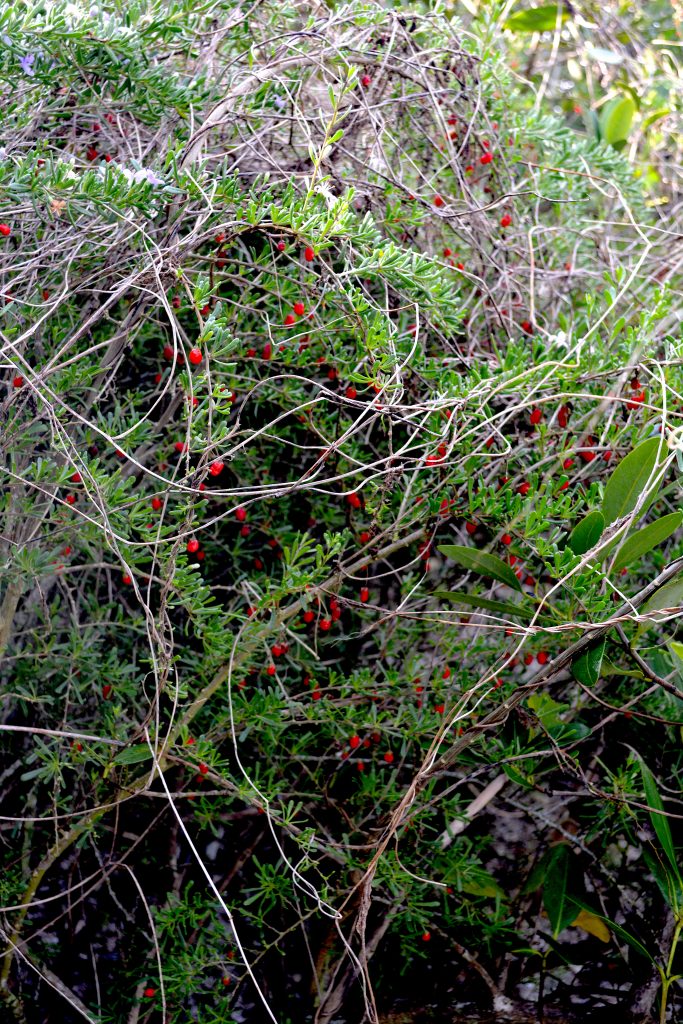
Christmas Berries actually fruited before Christmas rather than the usual April. Photo by Green Deane.
Usually we see Christmas Berries about April. In fact that’s when I made my video below. It was good for a change to see them in the Yule season. These bushes are quite happy and were seen during our foraging class Sunday near New Smyrna Beach (we also got to see the communication satellite launch.) Christmas Berries are our local Goji Berry and yes they are edible. These were slightly on the sweet side. They like to grow in areas with brackish water. To read more about them go here. And I have a video here.
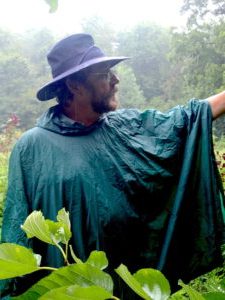
Classes are held rain, shine or cold.
Foraging Classes: Teaching in some familiar places this week, Live Oak Park in Port Charlotte and Mead Gardens in Winter Park.
Saturday, December 19th, Bayshore Live Oak Park, Port Charlotte, 9 a.m. to noon. Meet at the parking lot at the intersection of Bayshore and Ganyard Street.
Sunday, December 20th, Mead Gardens, 1500 S. Denning Dr., Winter Park, FL 32789. 9 a.m. to noon. The entrance is on the west side off Denning not the east side off Pennsylvania. Some GPS maps are wrong. Meet near the bathrooms.
Sunday, December 27th, Ft. Desoto Park, 3500 Pinellas Bayway S. St. Petersburg Fl 33715. 9 a.m. to noon. There is an entrance fee to the park. After you enter the park you arrive at a T-intersection. Turn right. Close to a mile later on your left is the fishing pier and parking lot. Meet near the bathrooms. There is considerable walking at this location.
Sunday, January 3rd, Jervey Gantt Recreation Complex, 2390 SE 36th Ave., Ocala, FL, 34471. 9 a.m to noon. Meet at the entrance to the pool, aka Aquatic Fun Center. There is no fee for this class. However, if you want to make a donation afterwards that’s up to you.
For more information, to prepay or to sign up go here. Don’t forget Dec.18th is my 10th annual Urban Crawl. It’s a free class in downtown Winter Park, starts at 10 a.m. in front of Panera’s.
When winter arrives in many places foraging slows down though I have an article on foraging up north in cooler months. Here our winter season is just starting with several plants one sees up north in spring or early summer.
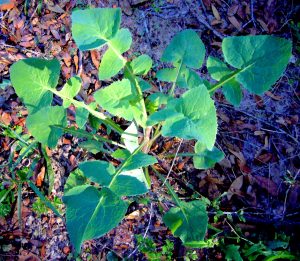
Common Sow Thistle. Photo by Green Deane
Sunday we saw young Common Sow Thistles near Daytona Beach. A Dandelion relative it, too, prefers the cooler months locally. Not a true thistle it is one of the more milder seasonal greens with only perhaps Amaranth being more mild. Although Sow Thistles are commonly called “thistles” they are not in the genus and do now draw blood like true thistles. True thistles are well-armed with needle-sharp spines. While the Sow Thistle can look intimidating it’s mostly just show in that most spines are soft. There are two species locally, the Common Sow Thistle and the Spiny Sow Thistle. The latter is a bit rougher than the former but no where near as abusive as true thistles. Both are slightly bitter raw. A few minutes of boiling takes away the bitterness completely (unlike wild lettuce which always stays slightly bitter.) I have a video on the sow thistles and to read more about them go here. My wild mustard video is here, and 106 videos later my Wild Radish video.
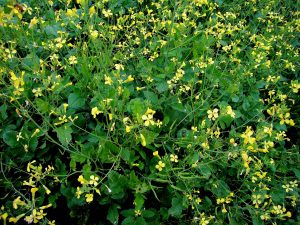
Wild Radish and Mustard are in blossom now. Photo by Green Deane
Mustards like chilly weather, or at least locally they do. You can see Wild Mustards and Wild Radish not only along roadsides now but in various fields from farm land to ignored citrus groves. The two species are used interchangeably and look similar. However Wild Radishes tend to be serpentine rather than straight and tall like Wild Mustard. They also have lumpy seed pods, or, more lumpy than mustard seed pods. Usually you will find a stand of one or the other. I don’t recall finding both in the same patch. Blossom colors can range from yellow to white with streaks of purple. But the leaves always have the biggest lobe on the end farthest from the plant. Look for them in sunny areas with fertile soil. Not native they came from Eurasia in the 1700s. And note the seeds can remain viable in the soil for up to 60 years. To read more Wild Radish go here, and for Wild Mustard, here. My wild mustard video is here, and 106 videos later my Wild Radish video.
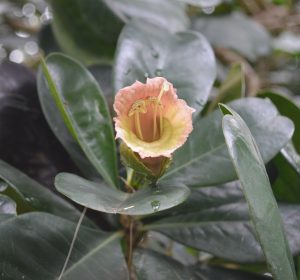
The blossom of the Black Calabash. Photo by Green Deane
We ran into a mystery during my Saturday class in West Palm Beach. It started with the blossom to the right. It was a large, dark-leafed tree with distinctive blossoms. After a few fits and starts Black Calabash seems a good fit, Amphitecna latifolia. Reports vary on edibility. Most agree the black seeds are edible. One book, A Field Guide to Plants of Costa Rica, says the spongy white pulp is edible but does not mention the seeds which makes me cautious (in that the authors might confuse edible seeds for edible pulp.) Other reports say the tree does not fruit often unless the blossoms are intentionally pollenated. One last thing: The skin was dried and used like cups.

Green Deane videos are now available on a USB.
A 150-video USB or 135 video DVD set would be a good winter present and either is now $99. My nine-DVD set of 135 videos has been selling for seven years and are still available. They are the same videos I have on You Tube. Some people like to have a separate copy. A second option is a16-gig USB that has those 135 videos plus 15 more. While the videos can be run from the DVDs the videos on the USB have to be copied to your computer to play. They are MP4 files. The150-video USB is $99 and the 135-video DVD set is now $99. The DVDs will be sold until they run out then will be exclusively replaced by the USB. This is a change I’ve been trying to make for several years. So if you have been wanting the 135-video DVD set order it now as the price is reduced and the supply limited. Or you can order the USB. My headache is getting my WordPress Order page changed to reflect these changes. We’ve been working on it for several weeks. However, if you want to order now either the USB or the DVD set make a $99 “donation” using the link at the bottom of this page or here. That order form provides me with your address, the amount — $99 — tells me it is not a donation and in the note say if you want the DVD set or the USB.

Green Deane Forum
Want to identify a plant? Perhaps you’re looking for a foraging reference? You might have a UFO, an Unidentified Flowering Object, you want identified. On the Green Deane Forum we — including Green Deane and others from around the world — chat about foraging all year. And it’s not just about warm-weather plants or just North American flora. Many nations share common weeds so there’s a lot to talk. There’s also more than weeds. The reference section has information for foraging around the world. There are also articles on food preservation, and forgotten skills from making bows to fermenting food.
This is weekly newsletter #436. If you want to subscribe to this free newsletter you can find the sign-up form in the menu at the top of the page.
To donate to the Green Deane Newsletter click here.

